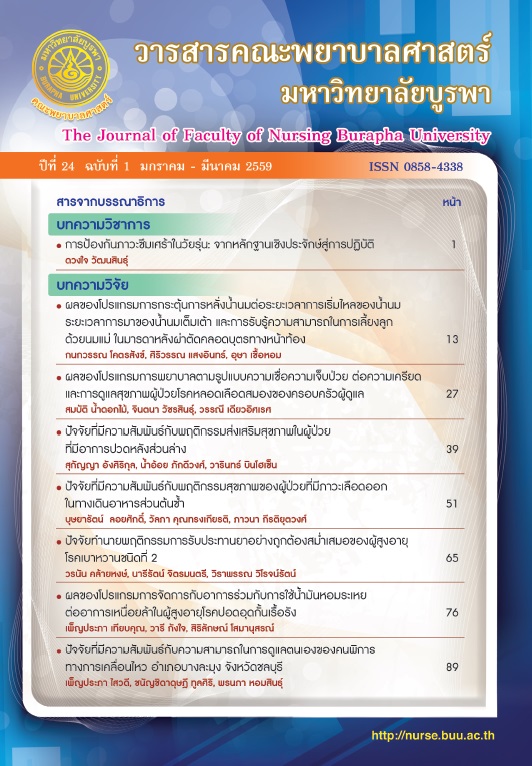ปัจจัยที่มีความสัมพันธ์กับพฤติกรรมส่งเสริมสุขภาพ ในผู้ป่วยที่มีอาการปวดหลังส่วนล่าง
คำสำคัญ:
พฤติกรรมส่งเสริมสุขภาพ, ผู้ป่วยที่มีอาการปวดหลังส่วนล่าง, Health promotion behaviors, patients with low back painบทคัดย่อ
บทคัดย่อ
การวิจัยเชิงบรรยายแบบหาความสัมพันธ์นี้ มีวัตถุประสงค์ เพื่อศึกษาพฤติกรรมส่งเสริมสุขภาพและปัจจัยที่มีความสัมพันธ์กับพฤติกรรมส่งเสริมสุขภาพของผู้ที่มีอาการปวดหลังส่วนล่าง โดยใช้รูปแบบการส่งเสริมสุขภาพของเพนเดอร์เป็นกรอบแนวคิดในการวิจัย กลุ่มตัวอย่างเลือกแบบเฉพาะเจาะจง เป็นผู้ที่มีอาการปวดหลังส่วนล่างที่มารับบริการที่แผนกผู้ป่วยนอก ห้องตรวจศัลยกรรมกระดูกและข้อ โรงพยาบาลชลประทาน มหาวิทยาลัยศรีนครินทรวิโรฒ จำนวน 88 ราย เก็บรวบรวมข้อมูลโดยใช้แบบสอบถามข้อมูลส่วนบุคคล ปัจจัยด้านการรับรู้ และแรงสนับสนุนทางสังคม วิเคราะห์ข้อมูลโดยใช้สถิตเชิงบรรยาย ไค-สแควร์และสัมประสิทธิ์สหสัมพันธ์แบบสเปียร์แมน
ผลการศึกษาพบว่ากลุ่มตัวอย่างส่วนใหญ่ (ร้อยละ 84.1) มีคะแนนพฤติกรรมส่งเสริมสุขภาพโดยรวมและรายด้านทุกด้านอยู่ในระดับปานกลาง –สูง ยกเว้นด้านกิจกรรมทางกายที่อยู่ในระดับต่ำ ระยะเวลาปวด การรับรู้ความสามารถตนเองและแรงสนับสนุนทางสังคมมีความสัมพันธ์ทางบวกกับพฤติกรรมส่งเสริมสุขภาพ (p <.01) ในขณะที่การรับรู้อุปสรรคมีความสัมพันธ์ทางลบอย่างมีนัยสำคัญทางสถิติ (p <.01) ส่วนอายุ ดัชนีมวลกายและการรับรู้ประโยชน์ไม่มีความสัมพันธ์กับพฤติกรรมส่งเสริมสุขภาพ ผู้วิจัยมีข้อเสนอแนะให้จัดโปรแกรมปรับเปลี่ยนพฤติกรรมส่งเสริมสุขภาพด้านกิจกรรมทางกาย โดยส่งเสริมการรับรู้ความสามารถตนเองและแรงสนับสนุนทางสังคม
Abstract
The objectives of this descriptive – correlational study were to describe health promotion behaviors and factors relating to health promotion behaviors of patients with low back pain. Pender’s health promotion model was used as conceptual framework. Eighty-eight samples were purposively selected. Questionnaire including demographic data, perception factors and social support was used to collect the data. Descriptive statistics, chi – square and Spearman’s rank correlation were used in data analysis.
The results revealed that overall health promotion behaviors, and each domain scores were at a high to moderate level except physical activity was at a low level. Factors significantly positive related to health promotion behaviors were duration of pain, perceived self-efficacy and social support. (p < .01) Whereas perceived barrier significantly negative related to health promotion behaviors. Age, body mass index, and perceived benefits did not relate to health promotion behaviors. Program for improvement of physical activity by enhancing perceived self-efficacy and social support is recommended.





